|

Taking GW Hoops to the
Next Level | GW Names New VP for Advancement
| Testing the College Waters | GW
on Television | Commencement Countdown
| Toast of the Town | The
Changing Face of Campus Cool | Fire Brings
Neighbors Together | Pharmacogenomics:
Individualizing Drug Therapy | Learning
the Ropes | Chalk-In Day | Cherry
Blossom Princesses | Faculty Focus: When
the Waters Went Down | George Welcomes
| The Mexican 'Mother Culture'
| At a Glance | GW
in History | A Faculty for
Writing

Taking GW Hoops to the Next Level
Men Bring Home First-Ever A-10 Title; Women Continue
NCAA Tournament Success
|
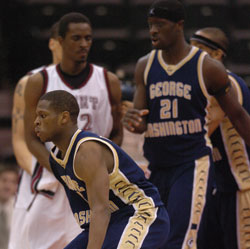
Senior T.J. Thompson and junior Pops Mensa-Bonsu take
on Saint Joseph’s during the A-10 championship
game.
Tim Boone/A-10
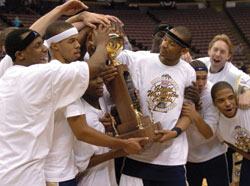
The men’s team celebrates with the A-10 championship
trophy.
Tim Boone/A-10
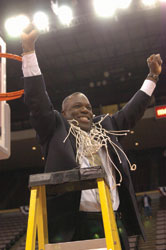
Men’s coach Karl Hobbs cuts down the net after
the A-10 championship victory.
Tim Boone/A-10
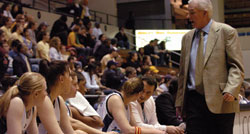
Joe McKeown this year completed his 16th season as
the women’s head coach.
Julie Woodford
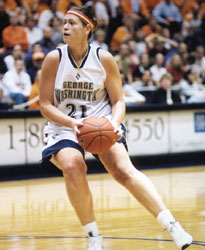
Senior Anna Montañana was a
dominant force on the women’s team this year.
Thomas Kohout
|
The men’s and women’s basketball
teams enjoyed memorable seasons this year, as both teams participated
in the NCAA Tournament and posted winning season records.
The 12th-seeded men’s basketball team
held its own against 2004 NCAA Tournament finalists Georgia
Tech but eventually lost to the fifth-seeded Yellow Jackets
80-68 in the first round of the NCAA tournament.
Following the game Coach Karl Hobbs turned
to the chalkboard to illustrate the team’s accomplishments
on the season.
“I wrote on the board A-10 regular
season championship, A-10 Tournament championship. I wanted
them to know how proud I was of them and that they were champions.”
says Hobbs.
GW’s men’s team made its first
NCAA Tournament appearance in six years by achieving a goal
the team had never accomplished—winning the Atlantic
10 Tournament. The Colonials’ 29-year A-10 Tournament
drought ended with a 76–67 victory over top-seeded Saint
Joseph’s. The win avenged a tough loss at home to the
Hawks, which might have nixed GW’s chances of making
the tournament had they not earned the conference’s automatic
bid, despite the fact that GW was also the regular season
A-10 champions.
“I’m still amazed,” says
senior T. J. Thompson. “In my first two years here, we
were at the bottom of the league, in last place. Last year
we took a step forward in the NIT. But nothing compares with
the feeling when you win the A-10.”
“We’re going to be more experienced
[next season], and we know what it takes to repeat as A-10
regular-season and tournament champs,” says junior Pops
Mensah-Bonsu.
The bid marked GW’s eighth appearance
in the NCAA Tournament and Hobbs’ first as a head coach.
The 2004 District 4 Coach of the Year, Hobbs is no stranger
to the competition in the field of 64. He spent eight seasons
as an assistant coach at the University of Connecticut, which
included its 1998–99 national championship season.
By winning the conference title and advancing
to the NCAA Tournament in his fourth season as head coach,
Hobbs confirmed the University’s decision to extend his
contract through 2011. Over the past two seasons, Hobbs’
teams have posted a 36–18 (.667) record and he has a
60–51 (.541) since replacing Tom Penders in 2001.“
Karl Hobbs has brought respectability and
a renewed spirit to the GW men’s basketball program,”
says Senior Vice President Robert Chernak.
Women’s Team
The ninth-seeded Colonials women’s
team advanced to the second round of the NCAA Tournament to
set up a rematch of its 1997 game against the top-seeded University
of North Carolina by defeating eighth-seeded University of Mississippi
in a thrilling 60–57 come-from-behind victory to start
the tournament.
Down by 14 points in the second half, GW
charged back into the contest with a 19–2 run, thanks
in part to a clutch performance by senior Anna Montañana.
Her steal, as well as a pair of free throws with nine seconds
remaining, sealed the Lady Rebel’s fate. Montañana
finished the game with 13 points to move past Elisa Aguilar
into 13th on GW’s career scoring list with 1,328 points.
About the come-from-behind victory, Coach
Joe McKeown says, “I expected it to be a good game, but
I didn’t expect to be down by 14 points in the second
half. We never quit, it has been that way all year.”
In the rematch of the 1997 Sweet 16 game
that propelled the Colonials to GW’s highest-ever NCAA
Tournament finish, GW faced a much stronger opponent. UNC
had notched 14 consecutive wins, and they dominated the contest
to win 71–47.
The women closed the season with a 23-9
record. “We had a great year—nobody expected us
to,” McKeown said. “We lost four seniors last year.
It was one of those years when you look back, you are going
to say, ‘that is one of the most fun years I’ve
ever had coaching,’ and I just want to thank our seniors
for giving me the opportunity to coach them.”
In a fitting capstone to the season, Montañana
in April signed a training camp contract with WNBA team the
Connecticut Sun. She joins two 2004 GW team members with training
camp contract, this coming season: Cathy Joens signed with
the Washington Mystics and Ugo Oha signed with the San Antonio
Silver Stars.
—Thomas Kohout
GW Names New VP for Advancement
|
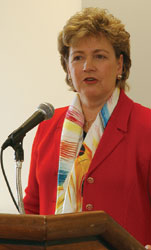
Laurel Price Jones is GW's new Vice President for
Advancement.
Thomas Kohout |
In January, GW President Stephen Joel Trachtenberg
announced the appointment of Laurel Price Jones as the new
vice president for advancement, a role she officially took
on in March. She leads GW’s fundraising campaigns and
oversees advancement and alumni relations programs. Formerly
vice president for development and alumni relations at Rochester
Institute of Technology and a fundraising expert for University
Hospitals of Cleveland and the Cleveland Clinic, she brings
20 years of experience to the University.
“Laurel has the tenacity and know-how
to leverage GW’s reputation, alumni, and academic excellence
to enhance our endowment, increase annual giving, and secure
more foundation grants,” Trachtenberg says.
Jones says she was attracted to the University
for several reasons. “GW is hot; everything your read
shows you it’s on the move. The University has a terrific
story—increasingly selective in terms of students and
faculty, strong and active alumni, good leadership, and a
mission. This is what you look for as a fundraiser, and I’m
very pleased to be joining the GW team.”
Testing the College Waters
Top high school students can now experience
authentic GW college life long before the senior prom. The
GW Summer Scholars Program, an intensive, six-week residential
program, enables rising high school seniors to take credit-bearing
courses at GW and experience first hand what college is all
about.
Launched in 2003, the program prepares students
for “the realities and rigors of college,” says
Georgette Edmondson-Wright, director of the program.
Students in the program take two courses
for credit—a required first-year writing class designed
to improve critical thinking and analytical writing skills,
plus a GW class of their choice from some 25 introductory
level courses. Enrichment workshops, faculty talks, site visits,
and departmental presentations round out the program. Other
highlights include college life seminars focusing on topics
like the admissions process and the freshman experience, recreational
activities, and field trips exploring educational and cultural
sites in Washington.
Participants live on GW’s Mount Vernon
Campus on Foxhall Road and take classes in Foggy Bottom. “GW
is uniquely positioned to provide students with an exciting
academic experience in the heart of the nation’s capital,
along with an intimate and nurturing residential experience
on the Mount Vernon Campus,” Edmondson-Wright says.
Students come to the program from across
the country and around the globe. “The majority of our
students come from Florida, California, and New York,”
Edmonson-Wright notes. “Last summer, we had participants
from Singapore and Japan, both of whom were children of GW
alumni.”
For high school students desiring a shorter
program, Summer Scholars offers two intensive, residential
10-Day GWorkshops on the Mount Vernon Campus in June that
focus on photojournalism and criminal law. Open to ninth through
eleventh graders, the noncredit mini-courses include site
visits to world-renowned institutions such as the FBI, National
Geographic, the Supreme Court, and the Smithsonian.
This expanding slate of offerings reflects
national trends, Edmondson-Wright says. “Nationwide,
the number of universities offering summer programs for high
school students has exploded in recent years, and we’re
bound to see continuing growth in these types of programs
as students and parents begin to prepare for college earlier.”
While she emphasizes that participating
in Summer Scholars has no bearing on applicants’ acceptance
to GW, Edmondson-Wright notes that half of the students enrolled
in the program’s 2003 inaugural class are now completing
their first year at GW. As of press time, more than 80 percent
of the 2004 participants had already applied to GW for the
coming academic year.
“The program fosters a real community
of scholars who keep in touch long after the summer ends,”
Edmondson-Wright says. “Students leave with a much stronger
sense of what college life and GW are all about. It’s
an excellent way to get an insider’s perspective on the
college experience and to get ready for the next step.”
—Jamie L. Freedman
GW
On Television
Students and alumni got the chance to be
in front of the camera during the spring semester as three
TV programs visited campus looking for news stories, would-be
moguls, and dorm rooms to renovate.
Students Produce WB Now
|

A crew from Inside Edition made over a residence hall
room shared by three students.
Thomas Kohout

Students and alumni hoping to be the next “Apprentice”
interviewed in groups with NBC casting producer Scott
Salyers in February.
Julie Woodward
|
GW’s School of Media and Public Affairs
students gained practical journalism experience working with
WB affiliate WBDC-TV to air the student-produced weekly public
affairs program, WB Now, which began in March. The
first installment focused on helping students manage the cost
of college. Other show topics include dealing with housing
costs and other matters relevant to students and recent graduates.
Students produce on-air packages, book show guests, report
and write scripts, and serve as camera operators. Senior and
program reporter Shaina Jones says the show is “a good
opportunity for us to learn more about the television industry
and about topics that relate to young professionals living
in the District.”
The Next ‘Apprentice’
Resumes in hand, more than 130 students
and alumni gathered in the Alumni House Feb. 10 for a private
casting call for the reality show The Apprentice.
They were interviewed in groups by NBC employees, and some
traveled from as far away as California and Boston for
the opportunity. The network, which held public tryouts
in Washington the next day, was looking for contestants
for both the original show starring Donald Trump and a
spinoff series featuring Martha Stewart. “Donald Trump
is big business and real estate, while Martha Stewart is
more media savvy. We’re looking
for a lot more public relations people for her show. Those
kinds of people are now trying out, where they didn’t
turn out for the original show,” says Scott Salyers,
cast producer. Salyers says the turnout for GW was unexpectedly
good; the network anticipated fewer than 50 hopefuls at the
campus call. Results of the GW interviews and the public
casting are top secret, so viewers will have to tune in
this fall to see what happened.
A Dorm Transformed
Five students kicked off the new year with
a new look for their residence hall rooms. On Jan. 28, a crew
from Inside Edition and interior designers with Bed,
Bath & Beyond transformed two spaces in Jacqueline Bouvier
Kennedy Onassis Hall for a “dorm room makeover”
segment. Rooms were selected through a lottery. Lucky students
Nicole Boye, Katie Dolence, and Sarah Jugo’s triple got
the full treatment with a top-to-bottom cleaning and reorganization
as well as colorful home accents. Jeremy Hall and Stephen
Tychanski’s double was updated with splashes of red and
organizing tools for the kitchen and bathroom. The segment
aired nationwide Feb. 9.
—LE
Commencement
Countdown
The commencement of the Class of 2005
will take place May 22 on the Ellipse between the South
Lawn of the White House and the Washington Monument.
Andy Rooney, longtime 60 Minutes correspondent,
will address the students and their guests.
MIT Physicist Mildred S. Dresselhaus,
Miami Herald Publisher Alberto Ibarguen, and Noted
Researcher Dr. Philip K. Russell also will be honored
during the ceremony.
|
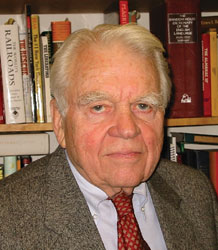 |
|
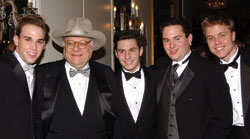
GW President Stephen Joel Trachtenberg celebrates
one of Washington’s biggest nights with students—GW’s
Inaugural Ball.
Thomas Kohout
|
Toast of the Town
Some 4,000 members of the University community
danced, dined, and enjoyed the entertainment Jan. 20 at the
GW Inaugural Ball at the Omni Shoreham Hotel. While President
Bush himself did not attend the festivities, “W”
impersonator Brent Mendenhall, live bands, student performers,
magicians, and a cowboy-hat-clad President Stephen Joel Trachtenberg
kept the black-tie affair swinging. It was GW’s fourth
inaugural ball. Trachtenberg said he was pleased the students
experienced the “pageantry of this Washington tradition.”
Fire
Brings Neighbors Together
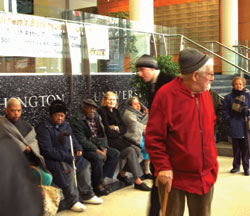
Julie Woodford |
Several residents
of St. Mary’s Court, a subsidized housing unit
for older adults located in the Foggy Bottom neighborhood,
were displaced in February when a fire damaged their
homes. They found aid and shelter in the GW community;
and though some sustained injuries, none were seriously
harmed. About 50 residents regrouped at the Marvin Center
during and immediately after the fire, and GW’s
City Hall residence hall provided temporary housing
and meals for 10 of the neighbors. Students and staff
members helped residents move to safety, recorded their
contact information, and kept them company.
The incident
was not the first time the GW and St. Mary’s Court
communities have come together. Students involved in
the Office of Community Service, Residence Hall Association,
and other groups enjoy spending time with residents
through activities such as Bingo nights and Senior Prom—an
annual evening out celebrating senior citizens with
music, dinner, and dancing.
|
The Changing Face of Campus Cool
From Greek rush to the posters wallpapering
campus during student government elections, popularity has
long been part of student culture. Though not every Colonial
would admit to harboring hopes of being on the homecoming
court, many might agree that it’s hot to be cool. By
logging on to thefacebook.com, popularity today is not just
desirable—it’s quantifiable.
In February of 2004, Harvard student Mark
Zuckerberg and a few of his friends created thefaceook, a
cross between “a universal online database and an interactive
social networking interface,” says co-founder Chris Hughes.
“The idea was sort of an extension of the traditional
college facebooks with terrible ID photos and boring information.
After a few weeks of work and many late-night dorm room conversations,
thefacebook was released at Harvard.”
Now, 335 universities including GW have
thefacebook sites of their own. The overall program boasts
nearly 1,600,000 members, about 10,000 of whom are GW students.
While most users are students, faculty, staff, and alumni
are also able to sign up—Hughes says about 3 to 8 percent
of members are alumni, depending on the school. The only requirement
is the user must have a University e-mail address.
“Most of my friends are active on thefacebook;
I think I have about 275 friends from GW and other universities
across the country,” says junior Lauren Adams. She says
that the site allows her to keep in touch with the people
she knows and the people who wish to know her better. While
browsing through member profiles, users can “poke”
one another through online notification in order to “confirm”
a friendship. “The new connections that I have made are
mostly just from realizing that someone is friends with someone
else. In that sense, it is a very good networking tool,”
Adams says. It doesn’t hurt that confirming new friendships
ups the number of friends a user has—a figure prominently
displayed near the top of each profile. Gaining friends—even
if it’s just the guy you met in line at Wendy’s
last week—can become a spectator sport.
Posting photos, listing enrolled courses,
an automatic birthday reminder, displaying interests and contact
information, and leaving messages on virtual “walls”
are a few of the highlights of the site. Whether users are
scrolling through photos to see who has cute friends or desperately
searching for the phone number of classmates for last week’s
English lit notes, the site can be entertaining and informative.
Hughes says it is hard to describe an “average”
user experience. “You never really know what a user might
be doing when she or he has a browser window open on the site.
But we do know that 60 percent of our users log on to the
site in any given 24-hour period, and 90 percent of our users
have logged on within the past month,” he says.
Because users constantly update their profiles
and interests, the site changes every day to reflect everything
new and fun on campus—what club sport is gaining membership
and what color is the new black—a sort of mercurial yearbook.
Users can post and read notices about club
meetings, happy hours, and campus events. It becomes a one-stop-shop
for checking personal messages and finding out who’s
doing what when.
And then, there are the cliques, user “groups”
that anyone can create about just about any topic. Naturally
for GW there are “Democrat” and “Republican”
groups, but for those who want to tailor their political affiliations
even further, there are “Republican Princesses”
and “Democrats Against Hillary ’08!” There
are groups for every region and sub-region of the United States
as well as for several other countries. Campus news and current
events also have a home on GW’s site…several groups
have sprung up over the burning topic of polo shirt collars:
should they be worn up—a preppy status symbol—or
down as a protest against conformity and snobbery? Whatever
one’s opinion on the matter, there is a group to join:
“Collars Up!” or “Anti-Popped Collars”
or “I Don’t Care What You Do With Your Collars.”
Keeping track of connections and happenings
through thefacebook makes a campus seem simultaneously a small
world and an ever-changing social scene. But for many who
have experienced student days at GW, hasn’t that always
been the case?
—LE
Pharmacogenomics:
Individualizing Drug Therapy
Anyone who’s ever taken prescription
medication knows that one drug does not fit all. Adverse reactions
hospitalize millions each year, while so-called “miracle”
drugs for some yield no benefit to others. The days of matching
patients with the right drugs through trial-and-error will
soon be history, thanks to the revolutionary new field of
pharmacogenomics—the study of how genetic variations
affect the ways in which people respond to drugs. GW is leading
the way in the rapidly evolving discipline, teaming up with
Winchester, Va.-based Shenandoah University to offer the nation’s
first undergraduate program in pharmacogenomics this fall.
Combining the expertise of GW, with its
medical school and strength in the basic sciences, and Shenandoah,
with its school of pharmacy, the partnership provides an academic
solution to an exploding need in the marketplace. “This
new program involves the unique contributions of two dynamic
educational institutions and is designed to create a solution
to an existing and growing challenge of creating highly skilled
workers in the emerging field of pharmacogenomics,” says
GW President Stephen Joel Trachtenberg.
Falling under the umbrella of personalized
medicine, pharmacogenomics is the intersection of pharmacology
and genetics. The cornerstones of this fast-growing field
are tailoring drug therapies to individual patients based
on their genetic makeup and predicting drug responses in patients,
including the possibility of life-threatening side effects,
via genetic testing. Another feature of pharmacogenomics is
the potential to predict and prevent impending diseases before
symptoms begin through targeted drug interventions.
“Pharmacogenomics is going to revolutionize
the way we practice medicine,” says Allan Goldstein,
chair of GW’s department of biochemistry and molecular
biology. “In the near future, we’ll all carry around
a chip the size of a credit card containing our individual
human genome, and when we go to the doctor’s office,
they’ll plug it into a computer and then design a treatment
that is right for each patient. More than 100,000 Americans
die every year due to complications from medications that
they take, because their genomes are a little bit different.”
GW is well versed in the pharmacogenomics
field, thanks to the success of the University’s McCormick
Genomics Center. Established in 2001 with a $7.2 million gift
from the estate of Catharine Birch McCormick, MD ’37,
the center has quickly made a name for itself. “Pharmacogenomics
is a priority focus area for us,” says Tim McCaffrey,
the center’s director. “I believe that in the not
too distant future, many drugs will be co-prescribed with
genetic tests to gauge whether individual patients can take
them safely and whether they will be effective. All the technology
is there, and we’re eager to start applying it.”
Students enter the GW/Shenendoah program
as juniors, after completing at least 60 hours of coursework
from a community college or university, and go on to earn
a bachelor of science degree in health sciences with a specialization
in pharmacogenomics. Based primarily at GW’s Virginia
Campus, the program combines a focus on the basic sciences,
taught by GW faculty, with pharmaceutical courses taught by
Shenandoah faculty. The senior year curriculum doubles as
the first year of Shenandoah’s Doctor of Pharmacy program,
enabling students interested in completing a doctorate to
graduate in seven instead of eight years. Students who choose
to stop at the BS level will be well positioned to quickly
land positions in the burgeoning biotechnology workforce.
Johnson anticipates an inaugural class of
25 students this fall, quickly doubling to 50 students annually
in this emerging field that will soon be a $2 billion industry,
she says.
—JLF
|
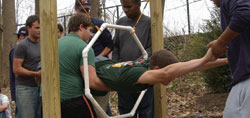
Julie Woodford
|
Learning
the Ropes
GW’s Mount Vernon Campus on Foxhall
Road opened SUMMIT, a low-ropes course designed for the
GW community, in April. The course gives teams of students,
staff members, clubs, and class groups the opportunity to
build communication, cooperation, and leadership skills
through challenging activities that require teamwork. Staff
and faculty members may train to become course facilitators,
and students are able to take a three-credit exercise science
course to develop facilitation techniques. While the ropes
course is designed primarily for the GW community, it is
available to outside groups on a limited basis. More information
can be found at http://gwired.gwu.edu/mvcl/SUMMIT or by
contacting (202) 242-6673 or mvcl@gwu.edu.
Chalk-In
Day
Since April 1981 the “Chalk-In
Day” at GW has been an annual tradition. For one
day every year in the spring, the University closes
H Street, in front of the Gelman Library, to traffic
to allow students to draw and design using chalk. This
design, from a previous year’s Chalk-In, is particularly
appropriate this year, as the city welcomes baseball
back to Washington. This season, many students can be
seen on campus in caps that are missing a “G”
and only carrying the script “W” of the Washington
Nationals.
|
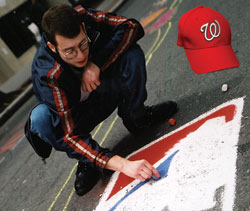
Thomas Kohout
|
Cherry
Blossom Princesses
Two GW seniors, Hunter Higgison (left) and
Meggie Baker, were selected as 2005 Cherry Blossom Princesses.
Baker, a criminal justice major who interns at the D.C. Superior
Court and plans to attend law school, represented South Carolina.
Higgison, a women’s studies major and communications
minor, represented the District of Columbia.
Participants toured D.C. during the National
Cherry Blossom Festival, visiting dignitaries such as first
lady Laura Bush and members of Congress, and spent time at
local schools and national monuments and museums. The National
Conference of State Societies has sponsored the competition,
which encourages scholarship and civic involvement, since
1948.
When
the Waters Went Down
During winter break, Associate Professor
of Journalism Janet Steele taught a narrative journalism course
in Jakarta while writing a book about Tempo magazine
and its relationship to the politics and culture of New Order
Indonesia. She arrived hoping to record the influence of the
media in the region—she left learning more about the
spirit of its people.
On Dec. 26, Steele was reading the newspaper
and “with some kind of weird ESP, was also thinking about
earthquakes,” she says. No one in Jakarta felt anything
that morning; within hours stories poured in about the devastating
earthquake and tsunami. “The first reports were from
Thailand, where dozens of Western tourists had been killed
in Phuket. But there was only an ominous silence from the
Indonesian island of Sumatra, about 90 miles from the epicenter
of the earthquake,” Steele says. The quake measured above
9.0 on the Richter scale and the resulting tsunami and damage
killed more than 120,000 in Indonesia alone.
“I spent the first 24 hours in a kind
of paralysis. By Thursday, it was clear that the scale of
the disaster was unimaginable. The images on Indonesian television
were heartbreaking,” she says. “Between 30 and 50
percent of the victims were children. When Tempo came
out the next week, its cover photo showed the corpse of a
child in a mud-smeared plastic bin. The headline read ‘S.O.S.’
”
Steele, who speaks Indonesian and volunteered
as a translator, says she was impressed by the work of Indonesian
journalists, noting their instinct to serve while many of
their colleagues were hurt or dead. “The television was
full of prayers and tears. Jakarta’s leading station,
Metro TV, has learned how to do the music, the titles, even
the ‘news ticker’ from CNN, but there was no denying
the appropriateness of their title, ‘Indonesia Menangis’—‘Indonesia
Weeps.’ A few days after the quake, one of the on-air
reporters broke down in tears.” Steele applauded the
efforts of Metro TV’s owner for sending a ship full of
250 volunteers and supplies to aid in the relief efforts.
Translating was one way for Steele to combat
the feeling of helplessness that permeated the region. “Several
journalism organizations banded together to get stories translated
and made available to an international audience. The fact
that the stories written by Indonesian journalists were being
translated made the Indonesian people feel that the world
was noticing their plight.”
A brief cease-fire in the Aceh region of
northern Sumatra in the protracted war between the Indonesian
military and the Free Aceh Movement was a small source of
hope in the region after the disaster. “There was a cease-fire,
but it was immediately violated,” Steele says. “The
tsunami did open up negotiations, but there have been no significant
break-throughs. The Indonesian government’s decision
to open up the region to outsiders was significant, and despite
the lack of immediate progress, I think there is still a
strong sense of possibility.”
At GW, Steele incorporates lessons from
Indonesia into her teaching. “I try to include Indonesian
perspectives on topics such as U.S. media coverage of the
war in Iraq.” Steele also speaks overseas for the State
Department, recently spending spring break in India discussing
the role of the free press in a free society.
Next year, Steele will return to Indonesia
on a second Fulbright grant, most likely teaching journalism
at the Dr. Soetomo Press Institute in Jakarta. She says now
that she’s finished her book, Wars Within: The Story
of an Independent Magazine in Soeharto’s Indonesia
(Equinox Publishing, 2005), she’s looking forward to
doing more comparative work, examining the role of journalists’
professional associations in developing and sustaining freedom
of expression.
She keeps in touch with her colleagues from
Tempo—managing editor Karaniya Dharmasaputra is
on campus on a Fulbright grant—and says she hopes her
next journey to Indonesia will be under better circumstances.
“Jakarta cancelled all its New Year’s
celebrations. Despite the official call for prayers and introspection,
at midnight there were nevertheless the sounds of fireworks,
small local displays that I could see from my balcony,”
Steele says. “Maybe the human spirit refuses to give
up hope, or maybe kids just like fireworks no matter what.
Or perhaps it’s the same thing.”
—LE
George
Welcomes...Headliners at University Events
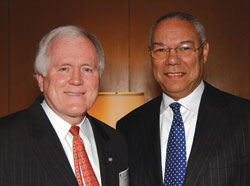 |
|
Edward M. Liddy, MBA ’72, head of the Allstate
Corporation and Allstate Insurance Company, was named
CEO of the Year by the GW School of Business Alumni
Association. The honor is presented annually. Liddy
accepted the award and gave a keynote luncheon address
in March. Former secretary of state Colin Powell, MBA
’71, attended the event.
Julie Woodford
|
|
Neil Sedaka, the singer and songwriter best known for
“Breaking Up is Hard to Do” and “Calendar
Girl,” performed in Lisner Auditorium at President’s
Night in February. Student Jonathan Kantor, a tenor
and alto saxophonist, joined Sedaka’s band for
a few numbers.
Julie Woodford
|
|
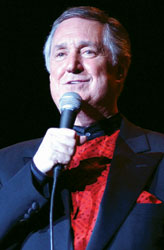 |
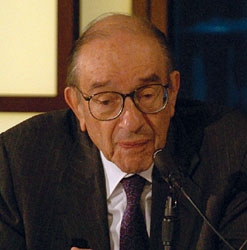 |
|
Federal Reserve Chairman Alan Greenspan and former
secretary of state and treasury James Baker were among
the witnesses who testified at President Bush’s
Advisory Panel on Federal Tax Reform held at GW in March.
At the event, (left) Greenspan said the U.S. tax code
should be simplified in order to boost economic growth.
Ben Solomon
|
|
Michael Chertoff, the newly confirmed secretary of
the Department of Homeland Security, discussed risk
management and its relevance to the future of his department
in an address sponsored by GW’s Homeland Security
Policy Insitiute on March 16 at GW’s Media and
Public Affairs Building.
Julie Woodford
|
|
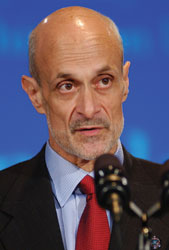 |
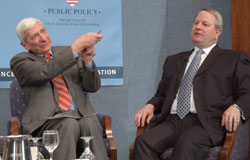 |
|
In February at the National Press Club in Washington,
Tony Tavares, president of the new Washington Nationals
baseball team, was a guest on GW’s “Kalb Report,”
a public affairs series hosted by journalist Marvin
Kalb. NPR host Scott Simon and Washington Post
columnist John Feinstein also joined the discussion,
which focused on whether the city can sustain a major
league franchise and the potential impact of the steroid
scandal that has put the sport in the headlines.
Thomas Kohout
|
The
Mexican ‘Mother Culture’
|
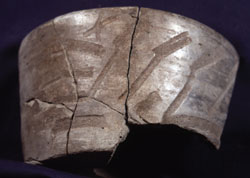
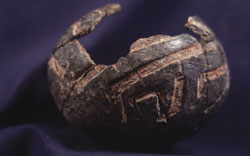
More than 1,000 pottery and clay samples such as these
were elementally analyzed by anthropology professor
Jeffrey Blomster and his team during their research
on the ancient Olmec. Their findings were significant
in explaining the origins of the Olmec and showing that
they were the first dominant civilization in Mesoamerica.
The research was featured prominently in a recent Science
section of The New York Times.
|
For more than a decade beginning in 1992,
assistant professor of anthropology Jeffrey Blomster led a
team that examined pottery samples throughout Mexico and Central
America. Elemental analysis supported their theory that the
ancient Olmec—best known as the creators of colossal
stone heads—synthesized Mesoamerica’s first unified
iconographic system and disseminated it to other cultures.
Blomster and his team believe the Olmec were the region’s
first dominant civilization, a “mother culture”
with significant influence on neighboring settlements.
Since the 1940s, researchers have debated
whether the Olmec were a mother culture in Mesoamerica or
rather a “sister culture,” one of several influential
peoples that developed simultaneously and contributed equally
to one another’s lifestyles and ideology. Blomster and
colleagues Hector Neff of California State at Long Beach and
Michael D. Glascock of the University of Missouri say their
findings support the priority of the Olmec in ideology and
published a provocative report in Science magazine in February.
While their research supports Olmec priority in synthesizing
a distinct ideology, the group emphasizes that the Olmec did
not “create” other civilizations in Mesoamerica—they
interacted with groups that had already achieved a certain
level of complexity.
The team conducted elemental analysis
of more than 1,000 pottery and clay samples from San Lorenzo—the
hub of early Olmec civilization—and six other sites that
were prominent between 1,200 and 900 B.C. during the “late
formative” Olmec period of 1,500 B.C. to 900 B.C. It
was possible to link 725 archaeological ceramic samples with
specific regions from which the clay originated. The ceramic
vessels they studied included ornamental “white wares,”
pottery and vessels with striking examples of Olmec style
iconography. Some of the artifacts incorporated orange coloring
exclusively used by Olmec artisans.
The results showed that all seven areas
had Olmec-style pottery and figurines—some that were
direct imports made in the San Lorenzo region and some that
were replicas made from local clays. What most interested
Blomster and his colleagues was that San Lorenzo had nothing
from the other sites—and that note of the other sites
had anything from one another, only from themselves and San
Lorenzo.
Blomster says that the reproductions of
Olmec pieces made in the other regions may not have had the
same prestige or value as the imported pieces from San Lorenzo,
a conclusion he formed because the original Olmec pieces were
found in the higher status households of local leaders or
people of wealth. “Higher-status houses at the other
sites had more access to original Olmec pottery. The difference
was in having the real thing versus obtaining a ‘knockoff,’”
he says.
While Blomster’s article sparked more
debate between the mother-culture versus sister-culture theorists,
he says he is pleased with the results and finds them to be
conclusive evidence of the significant prominence and influence
of the Olmec people. He says the presence of the original
Olmec artifacts and their replicas in other locations go beyond
the practice of exporting material goods, it indicates the
exporting of cultural values and beliefs.
“Our findings clearly show that the
Olmec in San Lorenzo had something to offer that was of great
interest to neighboring peoples and regions,” he says.
“They created and synthesized their symbolism through
their artifacts and disseminated it to other peoples.”
—LE
|